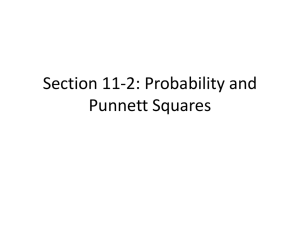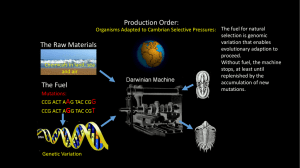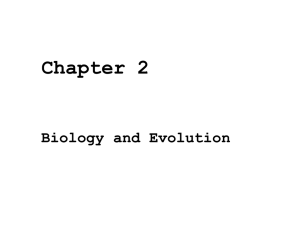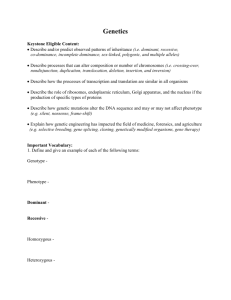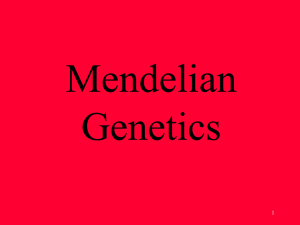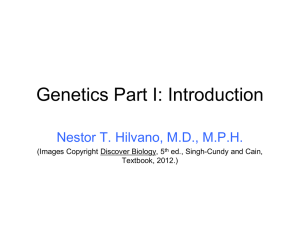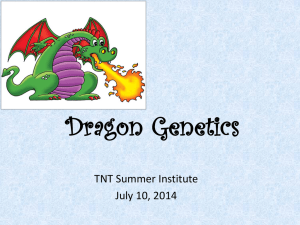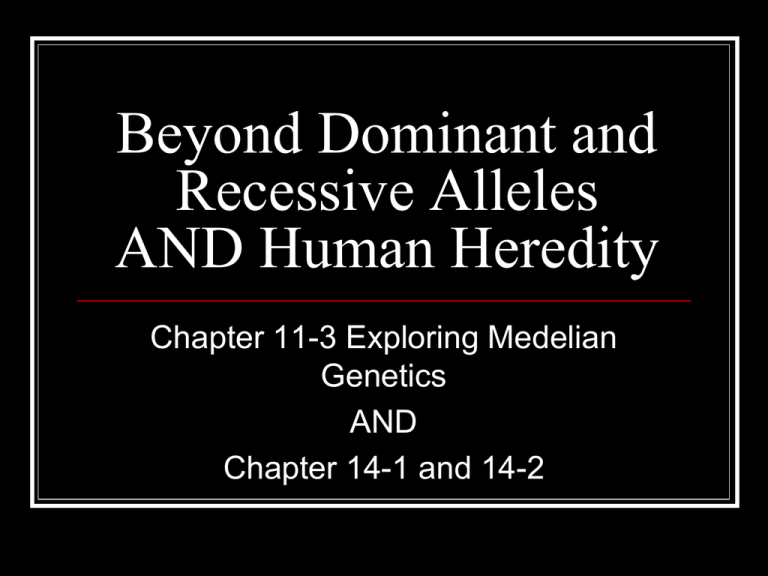
Beyond Dominant and
Recessive Alleles
AND Human Heredity
Chapter 11-3 Exploring Medelian
Genetics
AND
Chapter 14-1 and 14-2
Incomplete Dominance, Codominance,
Multiple Alleles and Polygenic Traits
and Human Heredity
Not all genes show simple patterns of
dominant and recessive alleles.
In most organism, genetics is more
complicated, because the majority of
genes have more than two alleles.
Also, many important traits are controlled
by more than one gene.
Incomplete Dominance
Neither
allele is dominant over
another so the heterozygous
individual is somewhere in
between (blend).
A cross between a red and white
Mirabilis plants (called four
o'clocks) have pink flowers.
In four o’clock plants, cross
a red flower and a white
flower. Show the genotype
and phenotype for F1.
RR x WW
R R
W
Key:
RR=red flowers
RW=pink flowers
WW=white flowers
p
W W
Genotype F1
W
R
RW
RW
R
RW
RW
4 =RW
Phenotype F1
4 =pink
F1
In four o’clock plants, cross
a pink flower and a pink
flower. Show the genotype
and phenotype for F1.
RW x RW
R W
R
Key:
RR=red flowers
RW=pink flowers
WW=white flowers
p
R W
R
W
RR
RW
Genotype F1
1 =RR
2 =RW
1 =WW
Phenotype F1
W
RW
1 =red
2 =pink
WW
1 =white
F1
roan hamster
Codominance
Both
alleles are equally
contributing or dominant so each
trait is shown.
A cross between a white and
black hamster can have a grey
appearance due to having BOTH
white and black hairs (mix).
These are worked the same as incomplete dominance
Cross a white fur hamster
and roan fur hamster.
Show the genotype and
phenotype for F1.
Key:
WW = white fur
WB = roan fur
WW x WB
What
percentage
of hamsters
are white?
Black?
Roan?
W W
W
BB = black fur
p
W B
W
B
WW
WB
Genotype F1
2 =WW
2 =WB
Phenotype F1
W
WW
2
2
WB
F1
=white fur
=roan fur
Test Cross
Test crosses are used to find the
genotype of parents. You need to
look at the offspring in order to
discover the genotype of a parent.
ALWAYS cross the unknown with the
known…. (the known is homozygous
recessive)
Cross homozygous dominant with
homozygous recessive then
heterozygous with homozygous
recessive
Key:
A tall pea plant was crossed with a short pea
plant. All of the offspring were tall….none were
short! What is the genotype of the tall pea
plant?
TT x tt
t
t
T
Tt
Tt
T
Tt
Tt
Genotype
4 Tt
Phenotype
4 tall
T = Tall pea plant
t = short pea plant
Tt x tt
t
t
T
Tt
Tt
t
tt
tt
Genotype
Phenotype
2 Tt
2 tall
2 tt
2 short
Multiple Alleles
Many
genes have more than two
alleles and are therefore said to
have multiple alleles.
This does NOT meant that an
individual can have more than two
alleles!
It means that more than two
possible alleles exist in a
population.
Genotype and Phenotype of blood:
AA and AO = type A blood
BB and BO = type B blood
AB = type AB blood
OO = type O blood
If a heterozygous type A
person is crossed with a
heterozygous type B, show
the genotype and and
phenotype of the F1 offspring.
Key:
AA and AO = type A blood
BB and BO = type B blood
AB = type AB blood
OO = Type O blood
AO x BO
A O
A
O
B
O
B
O
AB
AO
BO
Genotype F1
p
1 =AB
1 =AO
1 =BO
1 =OO
Phenotype F1
OO
F1
1
1
=type AB
=type A
1
=type B
1
=type O
Polygenic Traits
Many traits are produced by the interaction
of several genes (example is eye color, skin
color, height, facial features)
Traits controlled by two or more genes are
said to be polygenic traits, which means
“having many genes.”
For example, the wide range of skin color in
humans comes about partly because more
than four different genes probably control
this trait
http://www.athro.com/evo/inherit.html
Determination of Gender
What
are the chances of a couple
having a boy? Girl? Show your work!
Hint: females are xx and males are xy
x
x
xx x xy
x y
xx xy
xx xy
% chance of girl?
50%
% chance of boy?
50%
Sex Linked Genes
Genes
that are carried on the X
chromosome are expressed in the male
(since his other chromosome is Y)
Example: Red-green colorblindness –
recessive trait
Example: Hemophilia – recessive trait
Are you color blind?
Let’s take the Ishihara Test for
Color Blindness
Normal vision = 25
Normal vision = 29
Color blind = 25
Color blind = spots
What numbers
do you see?Red-Green
Red-Green
Normal vision = 45
Normal vision = 56
Red-Green
Red-Green
Color blind = spots
Color blind = 56
Normal vision = 6
Normal vision = 8
Red-Green
Red-Green
Color blind = spots
Color blind = spots
The test below is simpler.
The individual with normal color vision will see a 5 revealed in
the dot pattern.
An individual with Red/Green (the most common) color
blindness will see a 2 revealed in the dots.
The world.
How the world
looks to a
person with a
red/green color
deficit
(deuteranopia).
How the world
looks to a
person with a
blue/yellow
color deficit
(tritanopia).
Some colorful
hats.
As seen by a
person with
deuteranopia.
As seen by a
person with
protanopia,
another form of
red/green
deficit.
Let’s work a problem for sex linked genes
showing a cross between a colorblind male
and a female carrier (heterozygous).
Hint: color blindness is recessive so it will be lower case where
normal is capital.
Key:
XBY = male, normal
XbY = male, colorblind
XB XB = female, normal
XB Xb = female, normal (carrier)
Xb Xb = female, colorblind
Key:
colorblind male and
a female carrier
(heterozygous)
XbY
x
X BX b
B
X
b
X
b
X
B
b
X X
b
b
XX
Y
B
X Y
b
XY
XBY
= male, normal
XbY
= male, colorblind
XB XB
= female, normal
XB Xb
= female, normal (carrier)
Xb Xb
= female, colorblind
Genotype:
Phenotype:
1 = XBXb
1 = XbXb
1 = XBY
1 = XbY
1 = female, normal (carrier)
1 = female, colorblind
1 = male, normal
1 = male, colorblind
Sex limited traits
Appear only in certain gender
Example: Heavy beard is only in males
Sex influenced traits
Traits that are dominant in one gender and
recessive in another
Example: baldness (a woman must have
two dominant alleles to be bald and a man
only needs one dominant allele
Chromosomal mutations
An organism is missing a chromosome or
has an extra chromosome
Nondisjunction during meiosis
If the homologous chromosome do not
separate, one cell ends up with an extra
chromosome and the other cell is lacking a
chromosome.
In somatic (body) cells, its offspring is not
affected.
In gametes, the mutation is passed to the
offspring.
Nondisjunction during meiosis
Down’s Syndrome = has extra 21st
chromosome
Karyotype (picture of chromosomes)
Down’s Syndrome = has extra 21st
chromosome
Polyploidy
The nucleus does not divide after it duplicates its
DNA.
If it is fertilized, it ends up with an extra set of
chromosomes (3n)
In animals it is LETHAL (die)
In plants it makes them grow larger and healthier
Gene Mutations
Will be discussed after we learn about DNA
Homework Problems Set #3
1.
Rabbit spotted coat (R) is dominant
to rabbit solid coat (r).
A farmer has a spotted coat rabbit.
When the rabbit is crossed with a solid
coat rabbit, half are spotted and half are
solid.
What is the genotype of the spotted
rabbit? Show your test cross.
Homework Problems Set #3
2.
In cattle, red coat crossed with white
coat produces roan (pinkish brown).
Cross a red bull with a white cow (show
your work).
What percentage will be red? White?
Roan?
Homework Problems Set #3
3.
If a person with type AB blood has
children with a person who has type
O blood…
Show your work.
What percentage would be type AB?
Type O? Type A? Type B?
Homework Problems Set #3
4.
Hemophilia is a sex linked gene that
is carried on the X chromosome
exactly like color blindness.
Cross a Normal male with a Normal
female who is a carrier. Show your work.
What percentage of offspring would
have hemophilia? What percentage of
girls have hemophilia? % boys have
hemophilia?

